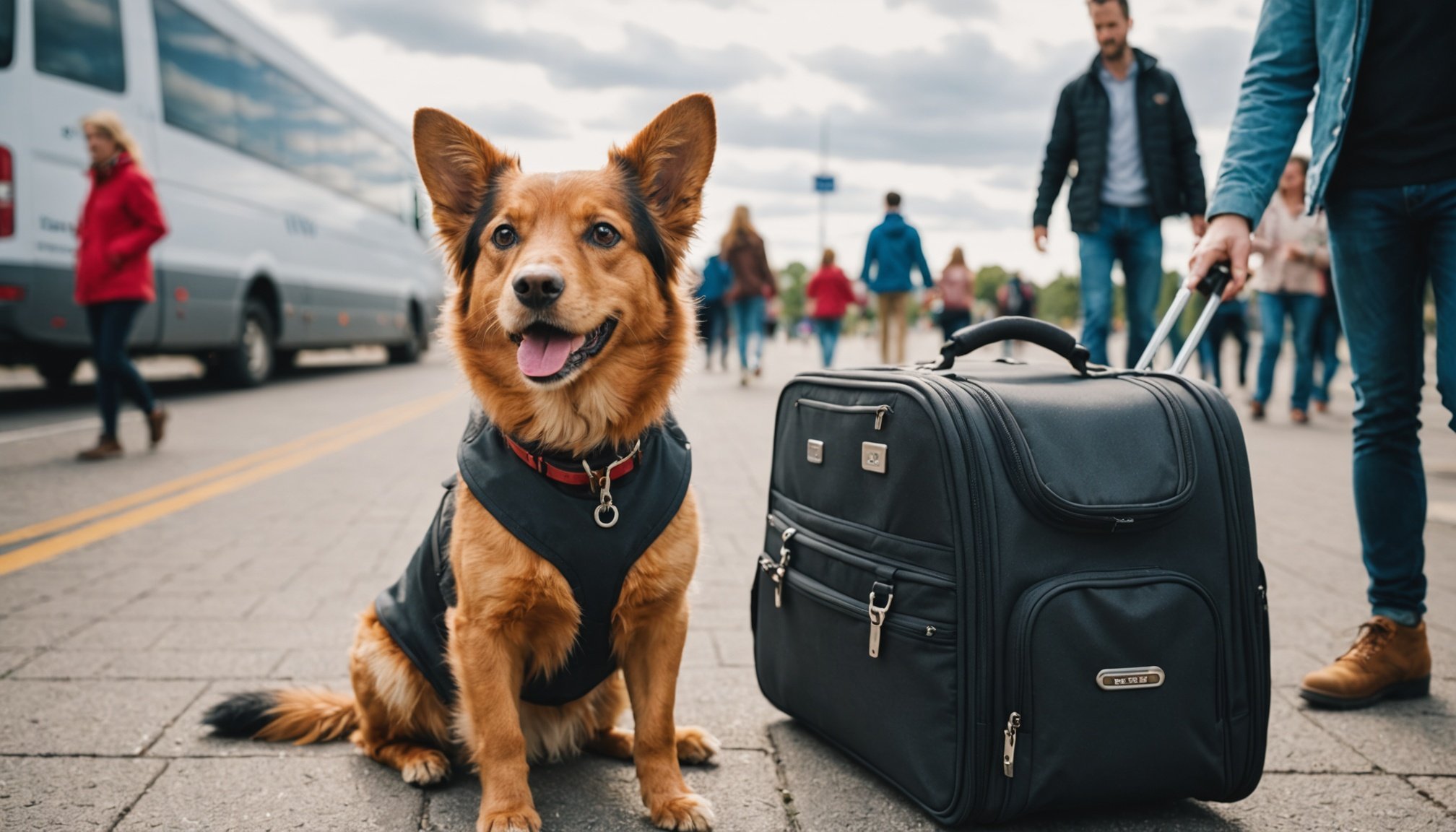Pre-Travel Preparation
Travel planning with pets requires meticulous attention to detail. Early planning is crucial to ensure your furry friend’s travel is as comfortable as possible. Beginning with researching pet-friendly accommodations is vital. Not all hotels welcome pets, so find establishments with the necessary amenities to cater to your pet’s needs.
Furthermore, veterinary check-ups are indispensable. Ensuring your pet’s vaccinations are up-to-date not only protects them but also complies with potential travel regulations. It’s advised to discuss with your vet if any additional preventive measures, such as flea or tick prevention, are recommended based on your travel destination.
Also to see : 10 ingenious ways to keep your furry friends entertained indoors
Moreover, creating a travel itinerary that includes pit stops and exploring pet-friendly parks can enhance the travel experience for your pet. These specifics can alleviate stress and reserve your pet’s energy for more travel fun.
Finally, keep in mind your pet’s preferences and routines when tailoring your travel plans. Using familiar items like their favourite blanket or toy can make new environments more comforting, aiding in a smooth transition as you embark on your journey together.
In the same genre : 10 ingenious ways to keep your furry friends entertained indoors
Packing Essentials
Providing optimal comfort for your pet during travel requires careful attention to their packing needs. A comprehensive list of must-have items ensures a seamless journey. Always pack your pet’s favourite bedding or blanket to provide a sense of familiarity and security in new surroundings. Toys that your pet enjoys can stave off boredom, keeping them engaged during transit.
Food and hydration are crucial aspects to consider while on the move. Ensure you have enough of your pet’s regular food, maintaining their dietary routine to avoid digestive upsets. Portable water bowls are indispensable, allowing easy access to clean drinking water. This helps prevent dehydration and maintains overall wellbeing during your trip.
In addition, packing essential medical supplies and documentation is paramount. Include a first-aid kit with necessary items such as bandages and antiseptic wipes for minor injuries. Ensure you have all necessary identification tags and health records, such as vaccination certificates, especially if crossing borders or staying in pet-friendly accommodations. These documents can prove vital in medical situations or emergencies, providing peace of mind and ensuring compliance with various regulations.
Transportation Safety Measures
Ensuring your pet’s safety during travel begins with selecting appropriate restraint options. In vehicles, pet seat belts or harnesses can effectively secure your pet, minimizing injury risks during sudden stops or accidents. Choose a harness that’s specifically made for travel to ensure a snug fit and maximum protection.
When considering airplane travel, understanding airline safety protocols is crucial. Check with your airline for specific rules about pet travel, as some require ventilated crates that meet their size specifications. Ensuring the carrier is sturdy and well-ventilated not only keeps your pet comfortable but also adheres to safety regulations.
It’s vital to select a travel carrier that suits your pet’s size and allows them to stand, turn, and lie down comfortably. This carrier security is especially significant for longer trips. For optimal safety, label the carrier with your contact details, in case of emergencies.
Whether by car or plane, prepping your pet with short practice sessions in their carrier beforehand can ease anxiety and prepare them for longer travels, making the journey safer and more pleasant for everyone involved.
Keeping Pets Calm During Travel
Maintaining calmness during travel involves multiple calming techniques tailored for your pet. Introducing your pet to travel environments early is beneficial. Familiarization can reduce anxiety, as pets are often comforted by routine. A smart technique is to take your pet on short, local trips in their carrier or in the car to simulate the travel setting beforehand.
For managing anxiety, consider natural supplements or calming products like pheromone sprays and collars. Products like these are specifically designed to reduce stress and are safe for most pets. However, it’s essential to consult your vet before introducing any new products to ensure they’re appropriate for your pet’s needs.
Creating a soothing environment during travel can also be achieved by maintaining a calm tone of voice and having familiar items nearby. Soft bedding, toys, or even an article of clothing with your scent can provide reassurance.
Incorporate relaxation into your travel routine by scheduling regular breaks to let your pet stretch and explore safely. Whether it’s a leisurely walk or some playtime, these activities not only provide physical exercise but also minimize stress, promoting a more tranquil journey.
Adjusting to New Environments
Helping pets adapt to new locations demands a thoughtful approach to ensure a seamless transition. Initially, allow your pet to explore their environment at their own pace, offering familiar objects like toys or blankets to anchor them in the new surroundings. This comforts them with familiar scents and appearances in an unfamiliar place.
Establishing a routine is vital. Structure feeding, walking, and playtimes as consistently as possible. This provides stability, helping pets feel grounded amid the changes. Similar to humans, pets thrive on predictability, which significantly boosts their confidence and acclimation to new environments.
When exploring the area, practice safety measures diligently. Leash your pet to prevent them from wandering into dangerous areas and ensure you are familiar with any local ordinances regarding pets to avoid potential legal issues. Additionally, identify nearby parks or open areas where pets can roam and exercise safely.
Proactively fostering your pet’s comfort and security while addressing unfamiliar areas methodically, you make their adjustment smoother. Enabling your pet to experience positive experiences in these settings becomes paramount in ensuring their overall wellbeing and happiness during travel.
Engaging Pets During Travel
Keeping pets stimulated during travel is pivotal to ensure a pleasant journey. Pet entertainment while traveling can encompass various activities to maintain engagement. Interactive toys are fantastic for this purpose. Pack a selection suited to your pet’s preferences, such as chew toys or puzzle feeders. These keep them busy and reduce anxiety.
During long trips, it’s vital to schedule ample playtime at stops. This allows pets to stretch their legs and expend energy, preventing restlessness. Plan stops where they can play safely and freely, possibly at designated pet areas or parks.
In transit, rotating toys can pique your pet’s interest. Introduce new toys gradually to sustain curiosity. Additionally, interactive games like tug-o-war or fetch can be initiated in safe, controlled environments during breaks.
An often-overlooked technique is providing a visual stimulus. Position their carrier or seat by a window, allowing them to observe outside activities. This can be particularly captivating for pets who enjoy visual engagement, lessening feelings of confinement.
In essence, by integrating these strategies, you create a dynamic and entertaining environment, ensuring pets remain content and engaged throughout the journey.
Emergency Preparedness
Being prepared for emergencies when travelling with pets is crucial. An effective pet travel emergency plan starts with creating an emergency contact list. This should include your veterinarian’s contact information, local veterinary clinics at your destination, and emergency pet care services. These contacts can be lifesavers in case of urgent health issues.
Identifying nearby veterinarians and clinics before embarking on a journey can significantly reduce response time if medical attention is needed. Researching these facilities ensures they are reputable and capable of handling emergencies. Don’t assume that every area will have suitable care; always double-check their operational hours and specialities.
Understanding local pet regulations and ordinances is vital to avoid unexpected legal troubles. Familiarize yourself with leash laws, vaccination requirements, and any breed restrictions at your destination. This knowledge prevents fines and ensures your pet is welcome wherever you travel.
Additionally, carry a pet-friendly first-aid kit, including essentials like bandages and antiseptic wipes. Having such a kit handy allows you to manage minor injuries promptly. With these preparations, you’ll be well-equipped to handle any emergency confident in the safety of your furry companion.
Post-Travel Care for Pets
Traveling can be taxing, so observing pets for any travel-related stress upon return is essential. Watch for changes in behaviour, eating habits, or sleep patterns. Adjust routines gently to help ease pets back into their daily habits after a trip. Gradual reintroduction to familiar activities gives them comfort and a sense of normalcy.
Post-travel care should focus on hydration and nutrition recovery. Ensure they’re drinking enough water, especially after long periods of travel. Check that they’re returning to their regular diet to maintain balanced nutrition. Offer small, frequent meals if they’re showing signs of reluctant eating, as this can aid in readjusting without overwhelming their system.
To help them acclimate back to home life, reintroduce regular playtime and exercise gradually. This avoids overwhelming them while still maintaining their physical health. Be attuned to any lasting signs of stress and consult with a veterinarian if behavioural changes persist beyond a reasonable adjustment period.
By giving attention to these elements, pet owners ensure a seamless transition back home, safeguarding their pet’s overall wellbeing and preventing travel-related health issues. Your pet will appreciate the considerate care you provide during this adjustment phase.
Sharing Your Travel Experiences
Sharing your travel experiences with pets can be both rewarding and educational for others. Documenting these journeys not only creates cherished memories but also serves as a resourceful guide for fellow pet owners. Capture every moment with photos and notes, highlighting enjoyable pet travel stories that can serve as valuable references for your future trips or to share with friends, family, and online communities.
Engaging with pet travel communities and forums can greatly enhance the communal knowledge of travelling with pets. By connecting with other pet owners, you can exchange practical insights, offer support, and learn from the diverse experiences of others. Forums provide a platform to ask about specific challenges, share success stories, and discover new travel tips or locations.
Contributing your personal travel anecdotes and tips can assist many who are contemplating similar adventures. Discussing your pet’s comfort strategies, preferred destinations, and any challenges faced offers real-life solutions for others. By providing detailed experiences, you’re not only preserving your memories but also enriching the broader pet travel community, creating a collective understanding and improving the travel experiences of countless pet lovers worldwide.




